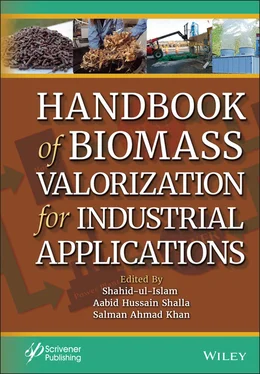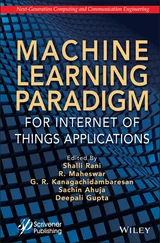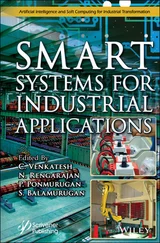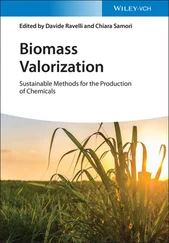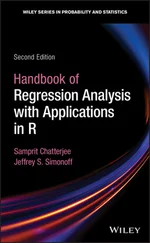Handbook of Biomass Valorization for Industrial Applications
Здесь есть возможность читать онлайн «Handbook of Biomass Valorization for Industrial Applications» — ознакомительный отрывок электронной книги совершенно бесплатно, а после прочтения отрывка купить полную версию. В некоторых случаях можно слушать аудио, скачать через торрент в формате fb2 и присутствует краткое содержание. Жанр: unrecognised, на английском языке. Описание произведения, (предисловие) а так же отзывы посетителей доступны на портале библиотеки ЛибКат.
- Название:Handbook of Biomass Valorization for Industrial Applications
- Автор:
- Жанр:
- Год:неизвестен
- ISBN:нет данных
- Рейтинг книги:4 / 5. Голосов: 1
-
Избранное:Добавить в избранное
- Отзывы:
-
Ваша оценка:
- 80
- 1
- 2
- 3
- 4
- 5
Handbook of Biomass Valorization for Industrial Applications: краткое содержание, описание и аннотация
Предлагаем к чтению аннотацию, описание, краткое содержание или предисловие (зависит от того, что написал сам автор книги «Handbook of Biomass Valorization for Industrial Applications»). Если вы не нашли необходимую информацию о книге — напишите в комментариях, мы постараемся отыскать её.
BIOMASS VALORIZATION
INDUSTRIAL APPLICATIONS
The handbook provides a comprehensive view of cutting-edge research on biomass valorization, from advanced fabrication methodologies through useful derived materials, to current and potential application sectors.
Audience Handbook of Biomass Valorization for Industrial Applications
Handbook of Biomass Valorization for Industrial Applications — читать онлайн ознакомительный отрывок
Ниже представлен текст книги, разбитый по страницам. Система сохранения места последней прочитанной страницы, позволяет с удобством читать онлайн бесплатно книгу «Handbook of Biomass Valorization for Industrial Applications», без необходимости каждый раз заново искать на чём Вы остановились. Поставьте закладку, и сможете в любой момент перейти на страницу, на которой закончили чтение.
Интервал:
Закладка:
Lignin is produced as a waste product when wood is processed into paper pulp. This waste stream of lignin has long been respected by researchers. Heavy chemistry involves the conventional process of extracting lignin from the pulp which has side effects. Therefore, lignin is typically burned by the paper industry, but it is a very loco-grade fuel. Instead of relying on the valorization of this deteriorated lignin side stream, an alternative approach was created to concurrently transform the wood into paper pulp used and products extracted from high quality lignin. The lignin can be isolated from the pulp and dismantled into smaller compounds with the proper temperature and promise. The effect is a lignin oil that can be turned into chemical building blocks more quickly. In essence, these building blocks can be used in plastic, insulation foam, coloring and flavoring solvents, pharmaceutical goods, dye, paint, etc.
2.5 Commercialization of Biobased Aromatics
With its use is primarily restricted to employ as a fuel in pulping boilers, lignin was seen as a waste product or a lesser important by-product of pulping. Recent trends in particular chemical processes make sure that lignin is no more essentially as chemically heterogeneous as it was historically manufactured either by pulping or other means. The chemical companies are now expanding their end-user applications, adding to feedstock supported specifications which can satisfy the requirements of these emerging users as well as integrate new properties into them.
The analysis of lignin in substance purposes can be sub-classified into separate subdivisions because of the enormity of the assignment, even though there are a number of differences between these which are explained as follows:
2.5.1 Phenolic Resins
Biological alteration by lignin. Its reactivity improved in response to lignin’s oxidatively crosslinked enzyme systems or else prior reaction of lignin to methylated phenols [81].
Peng and Riedl utilized starch as fillers in phenol-formaldehyde resins and identified that p–p link arrangements were strengthened with lingo-sulfate. So lingo-sulfate is the basis of lignin. Besides, when wheat derived starch was utilized, the least quantity of condensation was produced, yielding the maximum reactivity of lignin–starch formaldehyde mixtures [82].
The use of novel approaches that are based on lignin. Efficient phenol diluents in lignins derived from hydrolysis of acetosolv acid and organosolv processes have been shown to be phenol–based resin systems.
Cetin and Ozman observed that substitution of organosolv lignin on behalf of phenol in phenol–formaldehyde resins has shown adequate resin characteristics and has excellent curing characters relative to lignin-free resin [83, 84].
The promotion of lignin for phenolics on an economic basis alone is reliable.
2.5.2 Epoxies
The application of lignin in resin is an attached cross-linker in the typical epichlorohydrin reaction. Here lignin can report the bulk properties. For this mode of usage [84], lignin must be impurity-free. This can be accomplished by the purification of waste lignins derived from conventional pulp and paper processes or through the use of lignin. Many inventions and publications have been made based on developments in lignin–epoxy, but perhaps the newest is its use in PCB (Printed Circuit Boards).
Cazacu and Popa and Simionescu et al . have proved that epoxy embedded resins supported lignin can be manufactured in substantial amounts by relatively effortless purification methods. This includes epichlorohydrin reaction with lignin and succeeding reclamation and filtration of idle epichlorohydrin to clean the final resin.
Epoxy–lignin mixtures produced from various forms of lignin revealed that combines comprising lignin hardwood segregated by Kraft system or else extracted by steam explosion crosslinked high efficiently compared to those produced from lignin softwood [84]. The demand for epoxy resins is economically vibrant and one where lignin possibly will grow as a crosslinking agent, with particular regard to phenol–epoxy resins.
If the industry grows and tends to grow in the intermediate to long period, there will be different chances for lignin, particularly as its intrinsic characters, often expressed in the ending manufactured goods, are defined in greater aspects.
2.5.3 Adhesives
A key entry point for lignin in adhesive subsector is expected to be the development of fibreboard. Gel permeation studies in the treatment of lignin in laccase beech fibers demonstrated significant enhancement in lignin molecular weight. It directly confirms that there is a possibility of lignin covalent inter-bonding occurrence. In addition, model compound experiments revealed that laccase treatment of compounds of the lignin model induces molecular weight increases that can respond further to cross-linking increases [84]. Given the growing regulations on the limitation of chemical use in the formation of fibreboard, alternative, cleaner supplies are likely to be pursued.
2.5.4 Polyolefins
Polyolefin (PO) might be a welcoming habitat for a feedstock of lignin and can be incorporated by polymer blends and UV stabilization. Contradictory reports exist concerning the advantages of incorporating lignin with polyolefin blend polymers. Mixing of Kraft and aminated lignins using polypropylene or polyethylene have manufactured polymers with enhanced strength, break elongation and other high mechanical indexes, respectively.
The recalcitrance to biodegradation is progressively a more significant parameter affecting plastics in general, whereas especially products dependent on polyolefin. This is one area of which the integration of lignin [87] offers major benefits.
As developed countries move from a predominantly agricultural economy to an industrialized economy, it is expected that there will be enlargement chances for Polypropylene to replace paper, wood, glass, etc. It is unlikely that any inroads will not be completed into this industry, in particular through the mixed polymer technique guiding to product properties associated with lignin.
2.5.5 Miscellaneous
Uses of lignin have been documented for a range of applications. They have been mentioned as binders in mortar and building structures, solution and metal sequestration, recyclable plastic preservatives, gel forming base, polyurethane copolymers, etc.
The utilization of binder and agglomeration are basic solid–solid dispersions with lignin helping to preserve & effect fluidity as am outcome of interactions between lignin–lignin, lignin–water [85]. By changing the lignin with amino and ammonium groups, metal sequestration may be improved. The amination of lignin along with epoxy amines increased the heavy metal sorption activity and also boosted ability of bile acid and cholesterol sorption. With regard to the economics of this very complex group, both evaporated lignin concentrate and spray-dried lignosulfonate as road binders are the main markets [86].
2.6 Conclusion and Prospects
It can be expected that lignin may be readily accessible raw material with comparatively less prices for manufacture of array products and dry lignin shall be available in near future. The advancement of applications based on lignin must go hand in hand with the planned enhanced manufacturing of lignin from pulp & paper industries. The application of lignin in wood adhesives and the utilization of lignin to manufacture aromatic chemicals are the promising value-added lignin applications.
Development of imaginative applications for more sustainable materials through monomers as new building blocks & oligomers towards new chemistry (bio and chemical catalysis)
Читать дальшеИнтервал:
Закладка:
Похожие книги на «Handbook of Biomass Valorization for Industrial Applications»
Представляем Вашему вниманию похожие книги на «Handbook of Biomass Valorization for Industrial Applications» списком для выбора. Мы отобрали схожую по названию и смыслу литературу в надежде предоставить читателям больше вариантов отыскать новые, интересные, ещё непрочитанные произведения.
Обсуждение, отзывы о книге «Handbook of Biomass Valorization for Industrial Applications» и просто собственные мнения читателей. Оставьте ваши комментарии, напишите, что Вы думаете о произведении, его смысле или главных героях. Укажите что конкретно понравилось, а что нет, и почему Вы так считаете.
